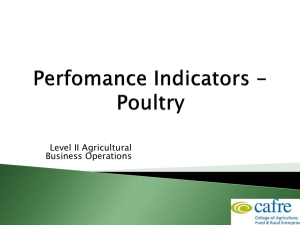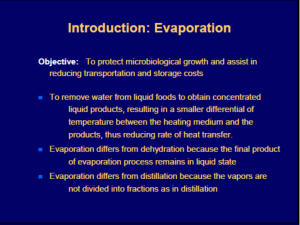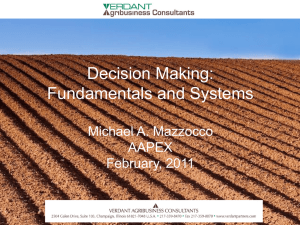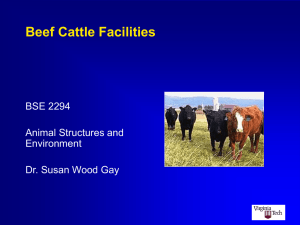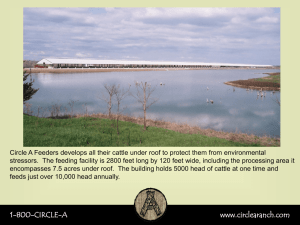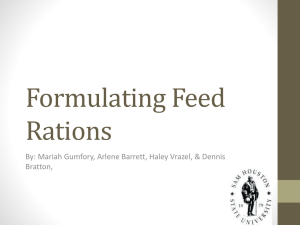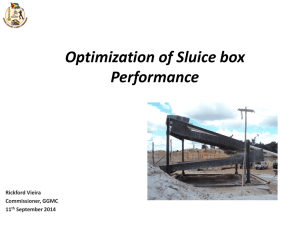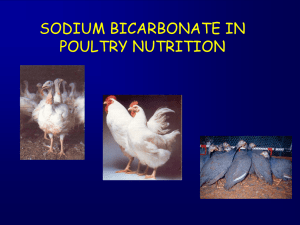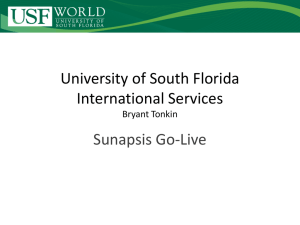EU Feed Rules and Feed Import Requirements and the Global Feed
advertisement
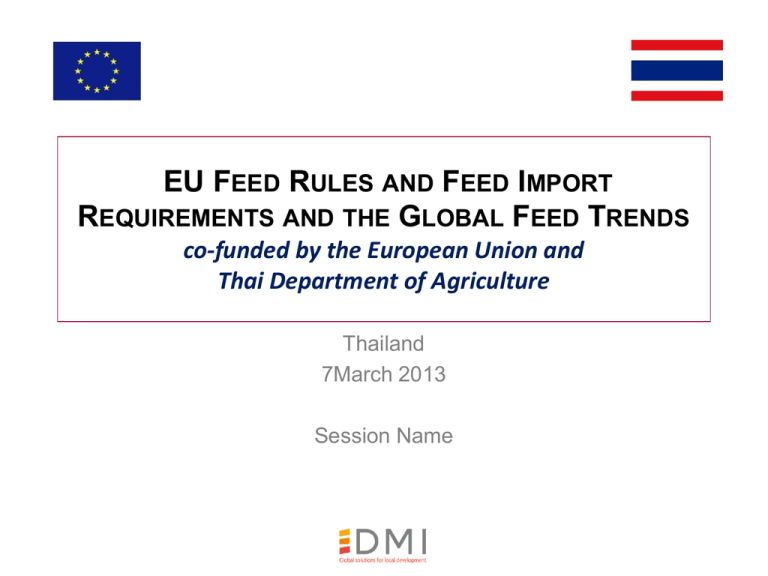
EU FEED RULES AND FEED IMPORT REQUIREMENTS AND THE GLOBAL FEED TRENDS co-funded by the European Union and Thai Department of Agriculture Thailand 7March 2013 Session Name Outline • Preliminaries – Key figures • Intensify animal production – compound feed • Upcoming regulations on animal feed safety • Control of feed preparation, manufacture and distribution Future Perspektives • Preliminaries • First conclusion: – Agricultural plant production has to be at least doubled until 2050 (WHO) – Intensification is clearly needed because arable land cannot be adequatly increased – Animal production is increasing over proportionate because of increasing income – To have enough ressources we have to intensify animal production as well – Mainly growing markets will be Asia and Africa • Intensify Animal Production Global Compound Feed Production 2011 • World industrial feed production in 2011 was an estimated: 873 million tonnes • The industry is worth approximately: US$ 350 billion Region Million Metric Tonnes Asia 305 Europe 200 North America 185 Latin America 125 Middle East / Africa 47 Other 11 Total 873 Source: IFIF / Alltech 2012 Global Feed Survey Evolution of global compound feed production 240 220 200 180 160 140 120 100 80 60 1999 2000 2001 2002 EU-27 Source: Fefac 2003 2004 Other Europe 2005 Brazil 2006 2007 China 2008 USA 2009 2010 Global Food & Feed outlook 2050 by IFIF • FAO estimates the world will have to produce ca. 60% more food by 2050 • OECD estimates the world will need 20% more food by 2020 • FAO estimates suggest that animal protein production will grow at least three times by 2050. – meats (poultry/swine/beef) will double – dairy will double – aquaculture production will grow tenfold Global Food outlook 2050 – regional trends by IFIF • IFIF anticipates significant feed production and animal protein growth in Asia, Africa and Latin America. • Expect to see wider geographic Europe, such as Russia and Ukraine, and certain regions in Africa catching up quickly on feed and food production. • Estimate CAGRs for animal protein production until 2020: – 2.55% in China – 2.47% India – 1.93% South America FAO Outlook 2010 – 2050: times 3! Source: IFIF Animal protein / million metric tons Pigs 201o 109,9 2020 128,81 Poultry Ruminants Aqua Total 98,2 67,5 33,9 309,50 115,09 79,11 59,57 382,58 2030 150,96 134,89 92,72 104,69 483,27 2040 176,93 158,10 108,67 183,98 627,68 2050 214,06 191,27 131,47 361,91 898,71 Source: FAO In 2050 - meats 536,80 million tons - + 1,6% APR - aqua 361,91 million tons - + 5,8% APR 3X • Conclusion 2 (for world market): – « Great future » - if plant production is able to meet the demand in high quality feed material – Growing demand for animal protein in food – Growing markets are located especially in Asia and Africa • Feed and Meat production in Europe Source: Fefac Source: Fefac Source: Fefac Source: Fefac Source: Fefac Source: Fefac • Conclusion 3 for Europe: – Compoundfeed is one of the most important tools to intensify animal production – Competition between food, feed and fuel use is possible - but not what we want – Demand for protein is more problematic than energy difficency on middle and long term – Several political economic programms are founded in EU to get more independent from imports (not only for GMO-reasons) • Upcoming regulations on animal feed safety • « Food has to be safe for consumers at any time » • « Feed is a part of the food chain and for that has to be safe as well as food » • No « waste » is allowed in animal feeding • This is, what Codex Alimentarius Commission stated after the first Task Force meetings on « animal feeding » • EU-regulations seem to be rather complete in terms of feed safety • from special cases of fraud we have to learn – Amendments of regulations are sometimes necessary to make fraud more difficult • Other Amendments react on very special cases (import regulations, e. g. for additives) or in case of new scientific evidence about risks • If all exisiting rules and regulations are followed we have safe feed, including the possibility of tracking and tracing and a lot of other measures • In « Codex alimentarius » we all together have to agree on the question what are the hazards and risks in food and feed: – Mykotoxins as thread for the whole production chain: very strikt rules in EU • Actual case in Germany • Scientist estimate 25 % of every years harvest has got high levels oof mycotoxins – unavoidable? • Worldwide efforts are necessary to fight mykotoxins esp. Aflatoxin – Different opinion about use of antibiotics (AB) in the production chain worldwide as e. g. processing aids • Very clear position in EU; not tolerable in any way – even not as performance enhancers or growth promoters • Use of AB has to be preserved for cases of deseases under control and with prescription of veterinarians • Where ever possible no use of AB in animal production, that are used in human medicine • Intolerable to use AB as processing aids e. g. in production of biofuel / ethanol, if there are residues left in later feed stuff • Agreement is necessary which antibiotic substances may be used in animal production legally and which maximum contents of residues are tolerable (e. g. coccidiostats) • Fighting against dangerous microorganisms in the food chain – EU began with fighting against salmonella – Complicated and expensive programms – More microorganisms will follow in next years • Codex alimentarius work is very useful and necessary!!! • Successful work since many years • On feed we had several meetings of the « task force animal feeding » years ago in Denmark and recently in Switzerland • All delegation did a good job to harmonise understanding about hazards and risk and their prioritisation • Conclusion 4: – Rules and regulations on safety in feed sector are rather complete in EU – New challenges may be found in microorganisms – Work of Codex Alimentarius is very necessary and worthy to harmonise understanding of hazards and efforts to fight them on international level Control of feed preparation, manufacture and distribution • Control of process is an interest of both: authorities and business operators – Feed and food safety aspects for officials – Effectivness for producer, e. g. use of electricity, reducing costs where possible • Traceability (tracking and tracing) is a key aspect for safety reasons – Very short time in alert situation – The quicker and better we are, the lower are risks and costs! – Key aspect also for additives! • Control of process of production and delivering: – Reduce crosscontamination where ever possible, if not tolerable – Know from whom you get rawmaterial, where it is used and who gets what; otherwise you have public recalls with name of company and product – Make sure to keep within minimum and maximum levels set by law; otherwise you more and more get the risk of publication and «blame and shame» – Exchange of information and data between different business partners and business operators gets more important! • Quality assurance systems – business driven systems besides regulated systems by law – Getting more and more important as a factor of trust between business partners as well as between business and consumer – Systems are coming closer together – Develoment to «chain covering» systems, not only additives, feed, food, distribution and point of sale – Be partner within systems like QS, GMP+, Ukasta etc. • «Green measures» – Ecologic production gets under pressure: Consumers in Europe begin to understand that ecologic business « is a business » and not «paradise» – In the aspect of setting new political rules on « green production »: • Set aside of areas (7 % of acres per farm) will happen only on voluntary basis; not mandatory – Problem: financial help by member states of EU for bio energy investments – Markets should work without political influence even in that area Thank you very much for your attendance ! I’m looking forward for an interesting discussion
